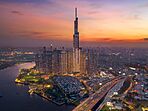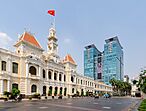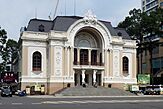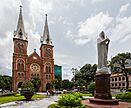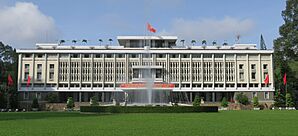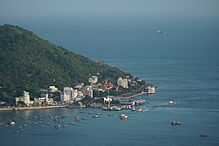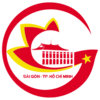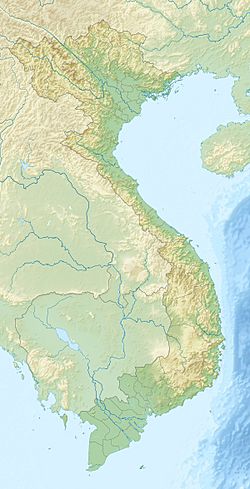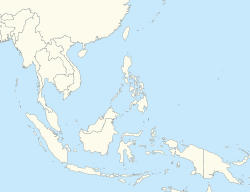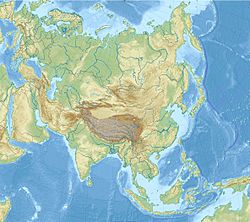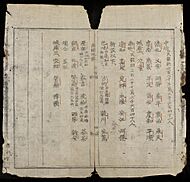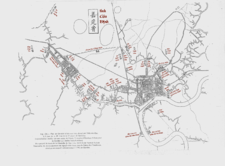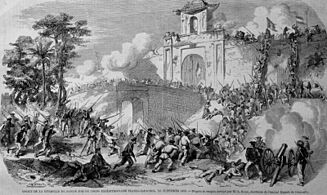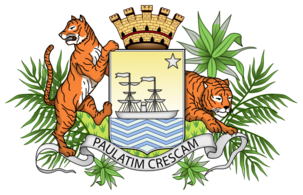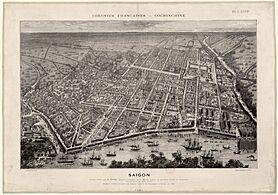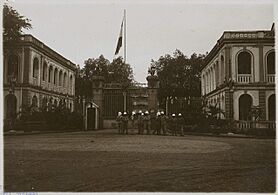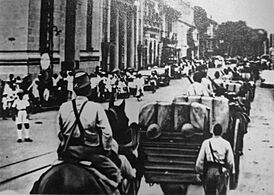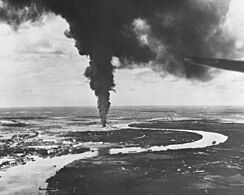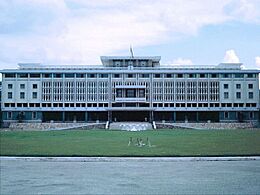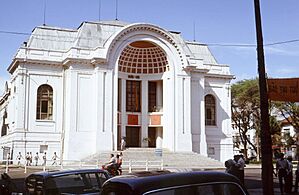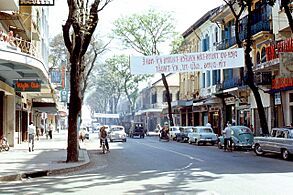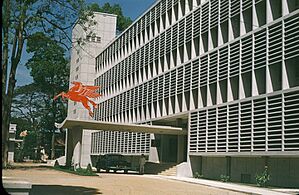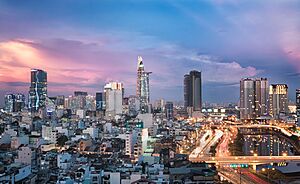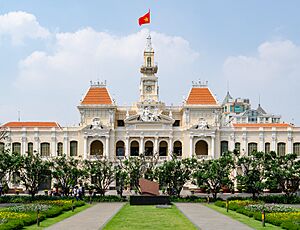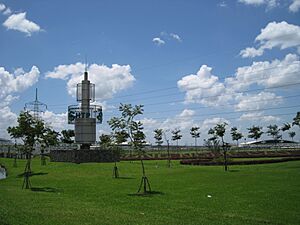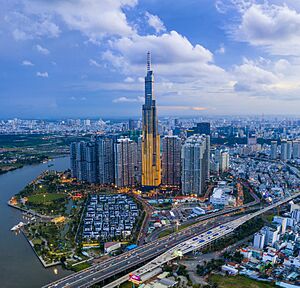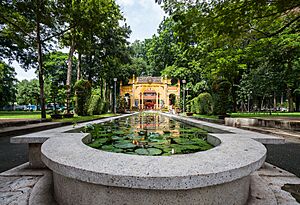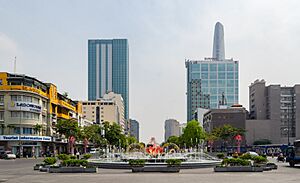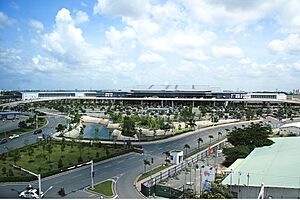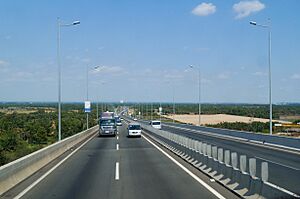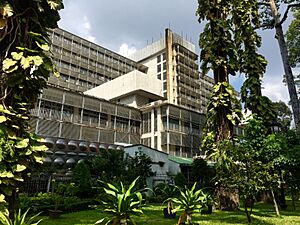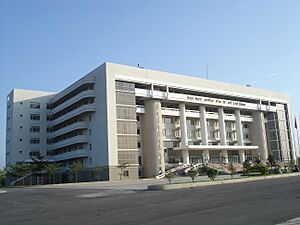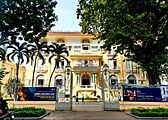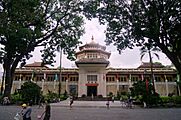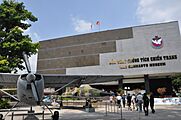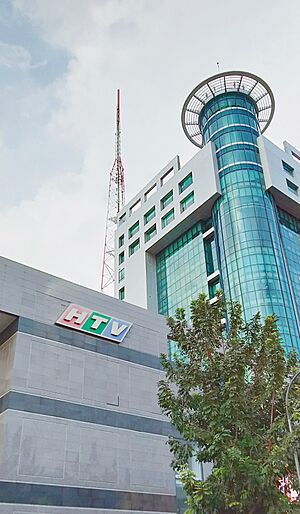Ho Chi Minh City facts for kids
Quick facts for kids
Ho Chi Minh City
Thành phố Hồ Chí Minh
Saigon (Sài Gòn)
|
||
|---|---|---|
|
Municipality (special)
|
||
| Ho Chi Minh City | ||
|
Skyline of Saigon Ward
Landmark 81
Ho Chi Minh City Hall
Saigon Opera House
Notre-Dame Cathedral Basilica of Saigon
Independence Palace
Vũng Tàu coastline
Thủ Dầu Một Clock Tower
|
||
|
||
| Nickname(s):
The city bearing the name of Uncle Ho (Thành phố mang tên Bác) The Pearl of Far East (Hòn ngọc của Viễn Đông) Paris of the Orient (Paris của phương Đông) Sài thành (The short way to call the "City of Saigon" (Thành phố Sài Gòn) in Vietnamese) |
||
| Motto(s):
Paulatim crescam (historical)
Meaning: Little by little we grow |
||
| Country | Vietnam | |
| Region | Southeast | |
| Founded | 1698 | |
| Change of name | 1976 | |
| Founded by | Nguyễn Hữu Cảnh | |
| Named for | Ho Chi Minh | |
| Government center | Saigon Ward | |
| Subdivisions | 113 wards, 54 communes and 1 special administrative region | |
| Government | ||
| • Type | Municipality | |
| • Body | Ho Chi Minh City People's Council | |
| Area | ||
| • Municipality (special) | 6,781 km2 (2,618 sq mi) | |
| • Metro | 30,595 km2 (11,813 sq mi) | |
| Elevation | 19 m (34 ft) | |
| Population | ||
| • Municipality (special) | 14,002,598 | |
| • Rank | 1st | |
| • Density | 2,067/km2 (5,350/sq mi) | |
| • Metro | 22,552,900 | |
| • Metro density | 737.143/km2 (1,909.19/sq mi) | |
| Demonym(s) | Saigonese | |
| GDP (Nominal, 2023) | ||
| • Municipality (Special) | US$114 billion | |
| • Metro | US$121 billion | |
| Time zone | UTC+7 (Indochina Time) | |
| Postal code |
70xxx–74xxx
|
|
| Area codes | 28 | |
| ISO 3166 code | VN-SG | |
| License plate | 41, 50–59 | |
| HDI (2022) | (3rd) |
|
| Rapid transit system | Ho Chi Minh City Metro | |
Ho Chi Minh City (HCMC), also known as Saigon, is the largest city in Vietnam. In 2025, its population reached over 14 million people.
The city is known for its many rivers and canals, with the Saigon River being the biggest. Ho Chi Minh City is Vietnam's main financial centre. It produces about a quarter of the country's total wealth. The larger Ho Chi Minh City area is also the 5th largest economy in Southeast Asia.
This area was once part of Cambodia. It became part of Vietnam in 1698. Later, it was the capital of French Cochinchina and then French Indochina. After Vietnam gained independence, it was the capital of South Vietnam until 1975. In 1976, it was renamed after the former leader, Hồ Chí Minh. However, many people still call it Saigon in everyday talk. Since the 1990s, the city has grown very quickly. This growth helped Vietnam's economy recover after the war. It also helped the city become an important place for international trade again.
Ho Chi Minh City is a major hub for business, fun, and learning in Southern Vietnam. It is also Vietnam's busiest international transport hub. Tan Son Nhat International Airport handles almost half of all international visitors to Vietnam. The Saigon Port is one of the busiest ports in Southeast Asia.
The city is a popular tourist spot. You can find many historic landmarks and modern buildings here. Some famous places include the Independence Palace, Bitexco Financial Tower, Landmark 81 Tower, the War Remnants Museum, and Bến Thành Market. The city is also famous for its narrow alleys and lively nightlife, especially in the Phạm Ngũ Lão Ward. In 2025, Ho Chi Minh City became an even bigger "megacity" after two nearby provinces joined it. This brought in more industrial towns and coastal cities. The city is now working to solve problems like sea level rise and flooding.
Contents
- City Names: Saigon and Ho Chi Minh City
- City History
- City Geography
- City Administration
- City Population
- City Economy
- Cityscape and Architecture
- City Transport
- Healthcare in Ho Chi Minh City
- Education in Ho Chi Minh City
- Tourism in Ho Chi Minh City
- City Culture
- City Media
- City Sports
- International Connections
- See also
City Names: Saigon and Ho Chi Minh City
The area was first known as a Cham settlement called Baigaur or a Cambodian village called Prey Nokor. In 1698, when Vietnamese people took control, it was officially named Gia Định. This name was used until the French took over in the 1860s. Then, it became known as Sài Gòn, which the French spelled as Saïgon.
The current name, Ho Chi Minh City, was given in 1976 after Vietnam was reunified. This was done to honor Ho Chi Minh. Even today, many people still use the name Sài Gòn when they talk. There is a small difference: Sài Gòn often refers to the city center, while Ho Chi Minh City includes all its urban and rural areas.
The Name Saigon
The name Sài Gòn likely comes from an old Cambodian name, ព្រៃនគរ (Prey Nokôr), which means "forest city" or "wooden city." Early Vietnamese writings from the 1700s used the Chinese characters 柴棍 to write the name, which sounds like "Sài Gòn."
Some people thought the name came from a Chinese word for "embankment," but this idea has been shown to be incorrect. The name Sài Gòn has a long history and is deeply connected to the city's past.
The Name Ho Chi Minh City
The official name, Thành phố Hồ Chí Minh, was first used in 1945 and officially adopted in 1976. It is often shortened to TP.HCM in Vietnamese and HCMC in English.
This name honors Ho Chi Minh, who was the first leader of North Vietnam. The name "Ho Chi Minh" means "enlightened will" or "light bringer."
Today, "Saigon" is still used often, sometimes even in official ways. It is used interchangeably with Ho Chi Minh City because of its long history and how familiar people are with it.
City History
Early Settlements
The first known settlement in this area was a Funan temple built around the 4th century AD. Later, in the 11th century, a Cham settlement called Baigaur was established. Around 1145, the Khmer Empire took control and renamed it Prey Nokor. This was a small fishing village surrounded by forest.
Vietnamese people began to move into the area without any official organization. In 1620, a Vietnamese princess married the King of Cambodia. This made it easier for people from both countries to move freely. The Cambodian King then gave Prei Nokor to the Vietnamese Nguyễn lords. Vietnamese settlers started to move into the Saigon and Đồng Nai areas. Before this, Funanese, Khmer, and Cham people had lived there for a very long time.
From 1623 to 1698, Saigon began to take shape. In 1623, the Nguyễn Lord asked the Cambodian King to set up tax stations in Prey Nokor (Saigon) and Kas Krobei. Even though it was a wild jungle area, it was important for trade routes between Vietnam, Cambodia, and Siam. Saigon grew from these early government centers.
Nguyễn Dynasty Rule
In 1679, Lord Nguyễn Phúc Tần allowed Chinese refugees to settle in Mỹ Tho, Biên Hòa, and Saigon. In 1698, a Vietnamese noble named Nguyễn Hữu Cảnh was sent to set up Vietnamese government structures in the area. This officially separated the area from Cambodia, which was not strong enough to stop it. Nguyễn Hữu Cảnh is often given credit for helping Saigon grow into a major settlement.
In 1788, Nguyễn Ánh took control of the city. He used it as a base to fight against the Tây Sơn. Two years later, a large fortress called Gia Định was built. This fortress was later destroyed by the French in 1859. The Vietnamese city, first called Gia Định, became known as Saigon in the 18th century.
French Colonial Era
In 1862, the city was given to France by the Treaty of Saigon. The French planned to turn it into a large city for their colony. In the late 1800s and early 1900s, many French-style buildings were constructed. These included a botanical garden, the Norodom Palace, Hotel Continental, Notre-Dame Cathedral, and Bến Thành Market. In 1865, the first newspaper in Vietnam, Gia Định Báo, was started in Saigon. During the French colonial period, Saigon became known as "Pearl of the Orient" or "Paris of the Extreme Orient."
In 1931, a new area called Saigon–Cholon was formed, combining Saigon and Cholon. The name Cholon was dropped after South Vietnam became independent in 1955. Saigon's population grew from about 256,000 in 1930 to 1.2 million in 1950.
- ''Gallery of Saigon during the French colonial era''
-
Coat of arms of Saigon established during French colonial administration and used from 1870 to 1975.
-
Imperial Japanese soldiers entering Saigon in 1941, during World War II.
-
Saigon afire after aerial attacks from carrier-based planes of the US Pacific Fleet in 1945.
State of Vietnam and Republic of Vietnam Era
On June 14, 1949, Saigon became the capital of the State of Vietnam. This state was part of the French Union. In July 1954, the Geneva Agreement divided Vietnam into two parts. The northern half was controlled by the Viet Minh under Ho Chi Minh. The southern half remained the State of Vietnam.
The State of Vietnam officially became the Republic of Vietnam in 1955, with Saigon as its capital. On October 22, 1956, the city was officially named Đô Thành Sài Gòn ("Capital City Saigon"). By 1975, the city had eleven districts.
Saigon was the main center for finance, industry, and transport in the Republic of Vietnam. In the late 1950s, the economy grew quickly. By 1960, over half of South Vietnam's factories were in Saigon. However, the city faced economic problems and high prices later on. The population grew to 3.3 million by 1970.
During the 1968 Tet Offensive, communist forces tried to capture the city but failed. Seven years later, on April 30, 1975, Saigon was captured. This ended the Vietnam War with a victory for North Vietnam. The city then came under the control of the Vietnamese People's Army.
- ''Gallery of Saigon during the Republic of Vietnam era''
-
The Independence Palace in 1967. It was the official residence and workplace of the President of South Vietnam.
-
The headquarters of StanVac (now part of Exxon) is an example of Vietnamese modernist architecture which boomed during the era.
After the Vietnam War and Today
In July 1976, after Vietnam was unified, the city of Saigon was combined with the Gia Ðịnh province and other areas. It was renamed Ho Chi Minh City to honor the late Communist leader Ho Chi Minh. At that time, the city covered about 1,295.5 square kilometers. Since 1978, the city's administrative areas have been changed many times. Most recently, in 2020, three districts were combined to form a new municipal city.
Today, Ho Chi Minh City and its surrounding areas are known as Vietnam's "manufacturing hub." It is also an "attractive business hub." In 2024, it was ranked as the 178th most expensive major city in the world. The city is also considered a "Beta+" city by the Globalization and World Cities Research Network, showing its importance in the world.
City Geography
The city is located in the south-eastern part of Vietnam, about 1,760 kilometers south of Hanoi. The city center is about 5 meters above sea level, and the suburbs are about 16 meters above sea level. It shares borders with several provinces and the South China Sea. The city covers an area of about 2,095 square kilometers. It stretches from Củ Chi District in the north to Cần Giờ District on the Eastern Sea.
Because it is located in the Mekong Delta, the city has many tidal flats. These areas have been changed a lot for farming.
Flooding Challenges
Ho Chi Minh City is one of the cities most affected by climate change, especially by flooding. During the rainy season, high tides, heavy rains, and high water levels in the Saigon River and Đồng Nai River can cause flooding. The land in the city is also sinking, which makes the problem worse. A very large flood, which might happen once every 100 years, could cause 23% of the city to flood.
City Climate
| Weather chart for Ho Chi Minh City, Vietnam | |||||||||||||||||||||||||||||||||||||||||||||||
|---|---|---|---|---|---|---|---|---|---|---|---|---|---|---|---|---|---|---|---|---|---|---|---|---|---|---|---|---|---|---|---|---|---|---|---|---|---|---|---|---|---|---|---|---|---|---|---|
| J | F | M | A | M | J | J | A | S | O | N | D | ||||||||||||||||||||||||||||||||||||
|
12
32
23
|
8
33
23
|
18
34
25
|
57
35
26
|
202
35
26
|
224
34
26
|
231
33
25
|
219
33
25
|
490
33
25
|
340
32
25
|
128
32
25
|
41
32
24
|
||||||||||||||||||||||||||||||||||||
| temperatures in °C precipitation totals in mm source: Vietnam Institute for Building Science and Technology, World Meteorological Organization (rainfall) |
|||||||||||||||||||||||||||||||||||||||||||||||
|
Imperial conversion
|
|||||||||||||||||||||||||||||||||||||||||||||||
The city has a tropical climate, specifically a tropical savanna climate. This means it has high humidity, usually between 78% and 82%. The year has two clear seasons. The rainy season lasts from May to November, with about 1,800 millimeters of rain each year. The dry season is from December to April.
The average temperature is 28°C, and it does not change much throughout the year. The highest temperature ever recorded was 40.0°C in April. The lowest was 13.8°C in January. On average, the city gets between 2,400 and 2,700 hours of sunshine each year.
| Climate data for Ho Chi Minh City (Tan Son Nhat International Airport) | |||||||||||||
|---|---|---|---|---|---|---|---|---|---|---|---|---|---|
| Month | Jan | Feb | Mar | Apr | May | Jun | Jul | Aug | Sep | Oct | Nov | Dec | Year |
| Record high °C (°F) | 36.4 (97.5) |
38.7 (101.7) |
39.4 (102.9) |
40.0 (104.0) |
39.0 (102.2) |
37.5 (99.5) |
35.2 (95.4) |
36.1 (97.0) |
35.3 (95.5) |
34.9 (94.8) |
35.0 (95.0) |
36.3 (97.3) |
40.0 (104.0) |
| Mean daily maximum °C (°F) | 32.0 (89.6) |
32.7 (90.9) |
33.6 (92.5) |
34.5 (94.1) |
34.9 (94.8) |
33.5 (92.3) |
33.0 (91.4) |
32.9 (91.2) |
32.6 (90.7) |
32.3 (90.1) |
32.4 (90.3) |
31.6 (88.9) |
33.0 (91.4) |
| Daily mean °C (°F) | 27.3 (81.1) |
27.5 (81.5) |
28.1 (82.6) |
29.3 (84.7) |
29.5 (85.1) |
28.8 (83.8) |
28.4 (83.1) |
28.3 (82.9) |
28.1 (82.6) |
28.0 (82.4) |
28.0 (82.4) |
27.3 (81.1) |
28.2 (82.8) |
| Mean daily minimum °C (°F) | 23.4 (74.1) |
23.1 (73.6) |
24.9 (76.8) |
26.4 (79.5) |
26.4 (79.5) |
25.5 (77.9) |
25.2 (77.4) |
25.1 (77.2) |
25.0 (77.0) |
25.0 (77.0) |
24.9 (76.8) |
23.9 (75.0) |
24.9 (76.8) |
| Record low °C (°F) | 13.8 (56.8) |
16.0 (60.8) |
17.5 (63.5) |
20.0 (68.0) |
21.1 (70.0) |
20.4 (68.7) |
19.4 (66.9) |
20.0 (68.0) |
20.8 (69.4) |
19.8 (67.6) |
17.6 (63.7) |
13.9 (57.0) |
13.8 (56.8) |
| Average rainfall mm (inches) | 12 (0.5) |
8 (0.3) |
18 (0.7) |
57 (2.2) |
202 (8.0) |
224 (8.8) |
231 (9.1) |
219 (8.6) |
490 (19.3) |
340 (13.4) |
128 (5.0) |
41 (1.6) |
1,970 (77.5) |
| Average rainy days | 2.0 | 1.0 | 1.0 | 4.0 | 13.0 | 16.0 | 19.0 | 17.0 | 18.0 | 16.0 | 9.0 | 5.0 | 121 |
| Average relative humidity (%) | 72 | 70 | 70 | 72 | 79 | 82 | 83 | 83 | 85 | 84 | 80 | 77 | 78 |
| Mean monthly sunshine hours | 245 | 246 | 272 | 239 | 195 | 171 | 180 | 172 | 162 | 182 | 200 | 226 | 2,490 |
| Source 1: Vietnam Institute for Building Science and Technology, | |||||||||||||
| Source 2: World Meteorological Organization (rainfall) | |||||||||||||
City Administration
Ho Chi Minh City is a special municipality, similar to a province in Vietnam. It is divided into 113 wards, 54 communes, and 1 special administrative region as of 2025.
The city's government is led by the Ho Chi Minh City People's Committee, which has 13 members. The current chairman is Nguyễn Văn Được. The city also has a legislative branch called the Ho Chi Minh City People's Council, with 105 members. Nguyễn Thị Lệ is the current chairwoman. The Ho Chi Minh City People's Court handles legal matters, and Lê Thanh Phong is the chief judge.
The local branch of the Communist Party of Vietnam also plays a key role in leading the city. The current secretary is Nguyễn Văn Nên.
List of HCMC administrative units
|
||||||||
|---|---|---|---|---|---|---|---|---|
| Name of district Dec. 2003 |
Sub-division units |
Area (km2) |
Population as of census |
Population as of census |
Population |
Population |
Population |
Population/km2 |
| Municipal city | ||||||||
| Thủ Đức | 34 wards | 213.5 | 664.655 | 845.924 | 860.006 | 880.109 | 966.201 | 4,122 |
| Urban districts | ||||||||
| District 1 | 10 wards | 7.73 | 198,032 | 180,225 | 187,435 | 185,715 | 193,632 | 24,025 |
| District 3 | 14 wards | 4.92 | 201,122 | 190,553 | 188,945 | 188,898 | 196,333 | 38,393 |
| District 4 | 15 wards | 4.18 | 180,548 | 180,980 | 183,261 | 183,043 | 186,727 | 43,790 |
| District 5 | 15 wards | 4.27 | 170,367 | 171,452 | 174,154 | 175,217 | 178,615 | 41,034 |
| District 6 | 14 wards | 7.19 | 241,379 | 249,329 | 253,474 | 251,902 | 258,945 | 35,035 |
| District 7 | 10 wards | 35.69 | 159,490 | 244,276 | 274,828 | 265,997 | 310,178 | 7,453 |
| District 8 | 16 wards | 19.18 | 360,722 | 408,772 | 418,961 | 421,547 | 431,969 | 21,978 |
| District 10 | 15 wards | 5.72 | 235,231 | 230,345 | 232,450 | 234,188 | 238,558 | 40,942 |
| District 11 | 16 wards | 5.14 | 224,785 | 226,854 | 232,536 | 234,293 | 230,596 | 45,582 |
| District 12 | 11 wards | 52.78 | 290.129 | 405,360 | 427,083 | 451,737 | 510,326 | 8,589 |
| Gò Vấp District | 16 wards | 19.74 | 452,083 | 522,690 | 548,145 | 561,068 | 634,146 | 28,423 |
| Tân Bình District | 15 wards | 22.38 | 397,569 | 421,724 | 430,436 | 430,350 | 459,029 | 19,229 |
| Tân Phú District | 11 wards | 16.06 | 366,399 | 398,102 | 407,924 | 419,227 | 464,493 | 26,103 |
| Bình Thạnh District | 20 wards | 20.76 | 423,896 | 457,362 | 470,054 | 479,733 | 487,985 | 23,109 |
| Phú Nhuận District | 15 wards | 4.88 | 175,293 | 174,535 | 175,175 | 175,631 | 182,477 | 35,990 |
| Bình Tân District | 10 wards | 51.89 | 398,712 | 572,132 | 595,335 | 611,170 | 686,474 | 11,778 |
| Total urban districts and municipal city | 249 wards | 496.04 | 5,140,412 | 5,880,615 | 6,060,202 | 6,149,817 | 6.508.647 | 12,398 |
| Districts | ||||||||
| Củ Chi District | 20 communes, 1 township | 434.5 | 288,279 | 343,155 | 355,822 | 362,454 | 403,038 | 834 |
| Hóc Môn District | 11 communes, 1 township | 109.18 | 245,381 | 349,065 | 358,640 | 363,171 | 422,471 | 3326 |
| Bình Chánh District | 15 communes, 1 township | 252.69 | 304,168 | 420,109 | 447,291 | 465,248 | 591,451 | 1841 |
| Nhà Bè District | 6 communes, 1 township | 100.41 | 72,740 | 101,074 | 103,793 | 109,949 | 139,225 | 1095 |
| Cần Giờ District | 6 communes, 1 township | 704.22 | 66,272 | 68,846 | 70,697 | 70,499 | 74,960 | 100 |
| Total (suburban) districts | 58 communes, 5 townships | 1,601 | 976,839 | 1,282,249 | 1,336,244 | 1,371,321 | 1.631.145 | 857 |
| Whole city | 249 wards, 58 communes, 5 townships | 2,097.06 | 6,117,251 | 7,162,864 | 7,396,446 | 7,521,138 | 8.072.129 | 3,587 |
City Population
| Historical population | ||||||||
|---|---|---|---|---|---|---|---|---|
| Year | Area km2 | Population | Person/km2 | Urban | Rural | |||
| Census | ||||||||
| 1999 | - | 5,034,058 | - | 4,207,825 | 826,233 | |||
| 2004 | - | 6,117,251 | - | 5,140,412 | 976,839 | |||
| 2009 | 2,097.1 | 7,162,864 | 3,416 | 5,880,615 | 1,282,249 | |||
| 2019 | 2,061.2 | 8,993,082 | 4,363 | 7,127,364 | 1,865,718 | |||
| Estimate | ||||||||
| 2010 | 2,095.6 | 7,346,600 | 3,506 | 6,114,300 | 1,232,300 | |||
| 2011 | 2,095.6 | 7,498,400 | 3,578 | 6,238,000 | 1,260,400 | |||
| 2012 | 2,095.6 | 7,660,300 | 3,655 | 6,309,100 | 1,351,100 | |||
| 2013 | 2,095.6 | 7,820,000 | 3,732 | 6,479,200 | 1,340,800 | |||
| 2014 | 2,095.5 | 7,981,900 | 3,809 | 6,554,700 | 1,427,200 | |||
| 2015 | 2,095.5 | 8,127,900 | 3,879 | 6,632,800 | 1,495,100 | |||
| 2016 | 2,061.4 | 8,287,000 | 4,020 | 6,733,100 | 1,553,900 | |||
| 2017 | 2,061.2 | 8,444,600 | 4,097 | 6,825,300 | 1,619,300 | |||
| 2025 | 9,816,320 | |||||||
| Sources: | ||||||||
| Historical population | ||
|---|---|---|
| Year | Pop. | ±% |
| 1995 | 4,640,400 | — |
| 1996 | 4,747,900 | +2.3% |
| 1997 | 4,852,300 | +2.2% |
| 1998 | 4,957,300 | +2.2% |
| 1999 | 5,073,100 | +2.3% |
| 2000 | 5,274,900 | +4.0% |
| 2001 | 5,454,000 | +3.4% |
| 2002 | 5,619,400 | +3.0% |
| 2003 | 5,809,100 | +3.4% |
| 2004 | 6,007,600 | +3.4% |
| 2005 | 6,230,900 | +3.7% |
| 2006 | 6,483,100 | +4.0% |
| 2007 | 6,725,300 | +3.7% |
| 2008 | 6,946,100 | +3.3% |
| 2009 | 7,196,100 | +3.6% |
| 2010 | 7,378,000 | +2.5% |
| 2011 | 7,517,900 | +1.9% |
| 2012 | 7,663,800 | +1.9% |
| 2013 | 7,818,200 | +2.0% |
| 2014 | 8,244,400 | +5.5% |
| 2015 | 8,307,900 | +0.8% |
| 2016 | 8,441,902 | +1.6% |
| 2017 | 8,446,000 | +0.0% |
| 2018 | 8,843,200 | +4.7% |
| 2019 | 9,038,600 | +2.2% |
| 2020 | 9,227,600 | +2.1% |
| 2021 | 9,166,800 | −0.7% |
| Source: Tổng cục thống kê Việt Nam | ||
In 2004, the city's population was about 6.1 million people. By 2009, it had grown to over 7.1 million, making it the most populated city in Vietnam. By the end of 2012, the population was about 7.7 million.
According to the 2019 census, Ho Chi Minh City had over 8.9 million people living in the main city area. Its larger metropolitan area had over 21 million people. In 2017, the city's mayor said the actual population, including unregistered residents, was likely around 13 million. People from Ho Chi Minh City are often called "Saigonese."
Ethnic Groups in Ho Chi Minh City
Most of the people in Ho Chi Minh City are ethnic Vietnamese, making up about 93.52% of the population. The largest minority group is the Chinese (Hoa), who make up 5.78%. The Cholon area is home to the biggest Chinese community in Vietnam. Chinese people here speak different dialects like Cantonese and Teochew.
Other smaller ethnic groups include the Khmer (0.34%) and Cham (0.1%). There are also many people from other countries living and working in Ho Chi Minh City, such as Koreans, Japanese, Americans, and French. Many of them live in Thủ Đức and District 7.
Religions in Ho Chi Minh City
As of April 2009, the city recognizes 13 religions. About 1.9 million residents identify as religious. Buddhism and Catholicism are the two main religions. Buddhism has the most followers, with over 1.1 million people. Catholicism is second, with over 745,000 followers. Other religions include Caodaism, Protestantism, and Islam.
City Economy
Ho Chi Minh City is Vietnam's main economic hub. Even though it is only 0.6% of the country's land area, it has 8.34% of Vietnam's population. It also contributes 20.2% of the country's total wealth (GDP) and 27.9% of its industrial output. In 2005, the city had about 4.3 million workers.
In 2009, the average income per person (GDP per capita) in the city was $2,800. This was much higher than the country's average of $1,042.
| Year | General description |
|---|---|
| 2006 | As of June 2006, the city had three export processing zones and twelve industrial parks. Ho Chi Minh City received the most foreign investment in Vietnam. By the end of 2007, it had 2,530 foreign investment projects worth $16.6 billion. |
| 2007 | In 2007, the city's GDP was about $14.3 billion, or $2,180 per person. This was up 12.6% from 2006 and made up 20% of Vietnam's GDP. The city's industrial production was $6.4 billion, which was 30% of the nation's total. Trade through HCMC ports was $36 billion, 40% of the national total. |
| 2008 | In 2008, the city attracted $8.5 billion in foreign investment. In 2010, the city's GDP was estimated at $20.902 billion, or about $2,800 per person. |
| 2012 | By the end of 2012, the city's GDP was estimated around $28.595 billion, or about $3,700 per person. This was up 9.2% from 2011. Total trade reached $47.7 billion. |
| 2013 | In 2013, the city's GDP grew by 9.3%. The GDP per person reached $4,500. |
| 2014 | By the end of 2014, the city's GDP grew by 9.5%. The GDP per person reached $5,100. |
| 2020 | The city's economy grew by 6.59% from 2016–2020. The GDP per person reached $6,328. |
| 2023 | In 2023, the city's GDP was $121.1 billion USD. The GDP per person was $9.6K USD. |
Economic Sectors
The city's economy includes many different industries. These range from mining, seafood processing, and farming to tourism, finance, and trade. Government-owned businesses make up 33.3% of the economy. Private businesses make up 4.6%, and foreign investments make up the rest. The service sector is the largest part of the economy (51.1%), followed by industry and construction (47.7%). Farming and other sectors make up a small part (1.2%).
The city and its ports are part of the 21st Century Maritime Silk Road. This trade route connects the Chinese coast to Europe.
Quang Trung Software Park is a special area for software companies in District 12. It is about 15 kilometers from downtown Ho Chi Minh City. This park helps the city become an important high-tech center in Vietnam and Southeast Asia. Many businesses, including large ones, work in high-tech, electronics, and light industries. Crude oil is also an important part of the city's economy.
Many investors are putting money into the city. Total local private investment was 160 billion đồng (about US$7.5 million) with 18,500 new companies starting up. Investments are focusing on high technology, services, and real estate.
As of June 2006, the city had three export processing zones and twelve industrial parks. It also has the Quang Trung Software Park and the Ho Chi Minh City Hi-Tech Park. Intel has invested about $1 billion in a factory here. More than fifty banks and about 20 insurance companies are in the city. The Ho Chi Minh City Stock Exchange, Vietnam's first stock exchange, opened in 2001. There are also many markets, supermarkets, and shopping malls.
City Growth and Development
With a population of over 8.3 million (as of 2010), the city needs more public buildings and services. To help with this, the city and central governments are building new urban centers. Two major projects are the Thủ Thiêm city center in District 2 and the Phú Mỹ Hưng Urban Area in District 7. These new areas include international schools like Saigon South International School and RMIT International University.
In December 2007, Phú Mỹ Hưng's new City Centre finished a 17.8-kilometer boulevard. This road connects the Saigon port areas to the main highway and the Mekong Delta. In November 2008, a new trade center, the Saigon Exhibition and Convention Centre, also opened. Phú Mỹ Hưng's new City Centre received the first Model New City Award from the Vietnamese Ministry of Construction.
In 2007, three million foreign tourists visited the city. This was about 70% of all tourists to Vietnam. Total cargo transported to the city's ports reached 50.5 million tons, almost one-third of Vietnam's total. In 2017, Ho Chi Minh City welcomed 6 million tourists.
According to Mastercard's 2019 report, Ho Chi Minh City was the second most visited city in Vietnam. It had 4.1 million international visitors in 2018. In the first half of 2025, HCMC welcomed over 22.1 million visitors, including 3.8 million international tourists. This generated about 118 trillion Vietnamese dong (around US$4.6 billion).
Cityscape and Architecture
Ho Chi Minh City has many interesting buildings with different styles from various time periods. You can see French influence from the colonial era throughout the city, especially in District 1. Famous French colonial buildings include the Ho Chi Minh City Hall, Saigon Central Post Office, Notre-Dame Cathedral Basilica of Saigon, and Bến Thành Market.
The city also has buildings inspired by Chinese architecture, mostly in Chợ Lớn, where many Chinese people live. One example is the Thien Hau Temple, built around 1760, making it one of the oldest historic buildings in the city.
During the Republic of Vietnam era, Vietnamese modern architecture started to grow. A key building from this time is the Independence Palace.
Parks and Gardens
Even though the city has many buildings, it also has several large parks. One of the biggest and most popular is Tao Đàn Park, located next to the Independence Palace. Other parks in District 1 include the September 23rd Park and 30/4 Park.
The Saigon Zoo and Botanical Gardens, in District 1, is one of the oldest zoos and botanical gardens in the world. It has over 600 rare animals and about 4,000 plant species, some over 100 years old.
Pedestrian Zones
Nguyễn Huệ Boulevard was the first pedestrian street in Ho Chi Minh City. It opened in April 2015 and is a popular place for locals and visitors to gather. Many events are held here throughout the year, including the annual flower festival during Tết.
Bui Vien Walking Street is also well-known. It is a popular area for backpackers and tourists. This street has many restaurants, coffee shops, hotels, live music pubs, and rooftop bars.
City Transport
Air Travel
The city is served by Tân Sơn Nhất International Airport. It is the busiest airport in Vietnam, handling over 15.5 million passengers in 2010. This is more than half of all air passengers in Vietnam.
Long Thành International Airport began operating in 2025. It is located about 40 kilometers east of Ho Chi Minh City. Long Thành Airport will handle international flights and can serve up to 100 million passengers per year when fully built. Tân Sơn Nhất Airport will then be used for domestic flights.
Rail Travel
The city is also a major stop for many Vietnam Railways train routes. The Reunification Express train runs from Saigon to Hanoi. It stops at cities and provinces along the way. The main train stations in the city are Sóng Thần and Sài Gòn. However, train travel is not as developed as other types of transport.
Water Transport
The city's location on the Saigon River makes it a busy port for trade and passengers. Many cargo ships use the port. Passenger boats regularly travel between Ho Chi Minh City and other places in Southern Vietnam and Cambodia. These include Vũng Tàu, Cần Thơ, the Mekong Delta, and Phnom Penh.
Water traffic between Ho Chi Minh City and Vietnam's southern provinces has grown over the years. The Đôi and Tẻ Canals, which are main routes to the Mekong Delta, see 100,000 waterway vehicles each year. In 2017, the Saigon Waterbus launched, connecting District 1 to Thủ Đức City.
Public Transport
Metro System
The HCMC Metro, a rapid transit network, is being built in stages. Line 1 opened in late 2024. This line connects Bến Thành to Suối Tiên Park in District 9. Planners expect this route to serve over 160,000 passengers daily. Another line between Bến Thành and Tham Lương has been approved. Several more lines are being planned.
Bus System
Public buses run on many routes throughout the city. Tickets can be bought directly on the bus. The city has several coach stations for buses traveling to and from other parts of Vietnam. The largest coach station is the Miền Đông Coach Station.
Private Transport
The main ways to get around the city are by motorbikes, cars, buses, taxis, and bicycles. Motorbikes are still the most common way to travel. Taxis are easy to find and usually use meters. For short trips, you can use "xe ôm" (motorcycle taxis). You can also book motorcycle and car taxis using apps like Grab and GoJek.
A popular activity for tourists is a tour of the city on cyclos. These allow for longer, more relaxed trips. In recent years, cars have become more popular. There are about 340,000 cars and 3.5 million motorcycles in the city. The increasing number of cars can cause traffic jams and air pollution. The government is working on plans to reduce the number of motorcycles and improve public transport.
Expressways
The city has two expressways that are part of the North-South Expressway system. These connect the city with other provinces. The first, Ho Chi Minh City – Trung Lương Expressway, opened in 2010. It connects Ho Chi Minh City with Tiền Giang and the Mekong Delta.
The second, Ho Chi Minh City – Long Thành – Dầu Giây Expressway, opened in 2015. It connects the city with Đồng Nai and Bà Rịa–Vũng Tàu. The Ho Chi Minh City – Long Khánh Expressway is also being planned for future construction.
Healthcare in Ho Chi Minh City
The city has a well-developed healthcare system. There are about 100 government-owned hospitals and medical centers. There are also many international facilities and private clinics. The 1,400-bed Chợ Rẫy Hospital is one of the largest. The French-sponsored Institute of Cardiology, Prima Saigon Eye Hospital, City International Hospital, and Franco-Vietnamese Hospital are considered top medical facilities in Southeast Asia.
- Notable hospitals in Ho Chi Minh City
-
City International Hospital is an international hospital in Ho Chi Minh City and Vietnam
Education in Ho Chi Minh City
High Schools
Ho Chi Minh City has many notable high schools. These include Lê Hồng Phong High School for the Gifted and Phổ Thông Năng Khiếu High School for the Gifted. High school in Vietnam covers grades 10 to 12. While most schools are public, private education is also available.
List of Public High Schools (Examples)
- VNUHCM High School for the Gifted
- Lê Hồng Phong High School for the Gifted
- Trần Đại Nghĩa High School for the Gifted
- Nguyễn Thượng Hiền High School
- Nguyễn Thị Minh Khai High School
- Bùi Thị Xuân High School
- Phú Nhuận High School
- Trần Phú High School
- Marie Curie High School
- Võ Thị Sáu High School
Private High Schools (Examples)
- Pennsylvania American International School
- Western Australian International School System
- APU International School
- Japanese International School
- Singapore International School
- Vinschool
- EMASI International Bilingual School
- Lawrence S. Ting Memorial School
Private Primary and Secondary Schools (Examples)
- ABC International School
- American International School, Saigon
- British International School Ho Chi Minh City
- British Vietnamese International School
- International School Ho Chi Minh City
- Saigon South International School
- Australian International School, Vietnam
- European International School Ho Chi Minh City
- Canadian International School Vietnam
- International German School Ho Chi Minh City
- Korean International School, HCMC
- Japanese School in Ho Chi Minh City
- Lycée Français International Marguerite Duras
- Taipei School in Ho Chi Minh City
- Renaissance International School Saigon
Universities
Higher education is growing in Ho Chi Minh City. The city has over 80 universities and colleges with more than 400,000 students. Important universities include Vietnam National University, which has 50,000 students across six schools. Other notable universities are The University of Technology, The University of Sciences, and The University of Social Sciences and Humanities.
There are also several private universities. One well-known private university is RMIT International University Vietnam, a campus of an Australian university. It has about 6,000 students. Another is The Saigon International University (SIU).
Tourism in Ho Chi Minh City
Tourist attractions in Ho Chi Minh City often relate to the French colonial period and the Vietnam War. The city center has wide boulevards and many French colonial buildings. Key landmarks include the Reunification Palace, City Hall, the Opera House, and Notre-Dame Cathedral Basilica of Saigon. Historic hotels like the Hotel Majestic and the Rex are also popular.
The city has various museums, such as the City Museum, Museum of History, and the War Remnants Museum. The Củ Chi tunnels, located northwest of the city, are also a popular historical site. The Saigon Zoo and Botanical Gardens is another old attraction, dating back to 1865. Recreational parks like Đầm Sen Tourist and Cultural Park and Suối Tiên Amusement and Culture Park are popular with visitors.
Ho Chi Minh City is also known for its many restaurants serving traditional Vietnamese dishes like phở. Backpacking travelers often visit the "Backpackers' Quarter" on Phạm Ngũ Lão Street and Bùi Viện Street.
In 2017, Ho Chi Minh City welcomed 6 million tourists. In 2018, it was the second most visited city in Vietnam, with 4.1 million international visitors. In the first half of 2025, the city welcomed over 22.1 million visitors, including 3.8 million international tourists. During the Tet 2025 holiday, the city earned about $303 million from tourism. In September 2025, HCMC is hosting ITE HCMC 2025, an event focused on sustainable tourism and trade.
City Culture
Museums and Art Galleries
Ho Chi Minh City's art scene is influenced by both Western and Eastern styles. Important places for art include the Ho Chi Minh City Museum of Fine Arts and various art galleries on streets like Nam Kỳ Khởi Nghĩa and Trần Phú.
Food and Drink
Ho Chi Minh City has a strong food and drink culture. You can find many roadside restaurants, coffee shops, and food stalls. Locals and tourists enjoy delicious local food and drinks at affordable prices. The city is ranked among the top five best cities in the world for street food.
City Media
The city's media is very developed. There are seven daily newspapers, including Sài Gòn Giải Phóng and Tuổi Trẻ, which has the highest circulation in Vietnam. There are also over 30 other newspapers and magazines. The city has many printing houses, bookstores, and libraries. The city's General Library holds over 1.5 million books.
Ho Chi Minh City Television (HTV) is the second largest TV network in Vietnam. It broadcasts 24/7 on 7 different channels. Many international TV channels are available through cable networks. The Voice of Ho Chi Minh City is the largest radio station in South Vietnam.
Internet access is growing quickly, with over 2.2 million subscribers. Mobile phone service is also very popular, with about 15 million cell phones in use.
City Sports
As of 2005, Ho Chi Minh City had 91 football fields, 86 swimming pools, and 256 gyms. The largest stadium is the 15,000-seat Thống Nhất Stadium. The Military Region 7 Stadium was one of the venues for the 2007 AFC Asian Cup finals. Phú Thọ Racecourse is the only racetrack in Vietnam.
The city is home to several football clubs. One of the largest is Ho Chi Minh City F.C., which has won Vietnam's V.League 1 four times. In 2011, the city got a professional basketball team, Saigon Heat. It was the first international professional basketball team to represent Vietnam. They have won the Vietnam Basketball Association championship three times. In 2016, a second professional basketball team, Wings, was created.
The city hosts many international sports events, such as the AFF Futsal Championship. Other sports like rugby, cricket, volleyball, and chess are also popular.
International Connections
Twin Towns and Sister Cities
Ho Chi Minh City has "twin town" or "sister city" relationships with many cities around the world. These partnerships help promote cultural exchange and cooperation.
 Ahmadi Governorate, Kuwait (2010)
Ahmadi Governorate, Kuwait (2010) Almaty, Kazakhstan (2011)
Almaty, Kazakhstan (2011) Auvergne-Rhône-Alpes, France (1998)
Auvergne-Rhône-Alpes, France (1998) Bangkok, Thailand (2014)
Bangkok, Thailand (2014) Champasak Province, Laos (2001)
Champasak Province, Laos (2001) Busan, South Korea (1995)
Busan, South Korea (1995) Guangdong Province, China (2009)
Guangdong Province, China (2009) Guangxi Zhuang Autonomous Region, China (2013)
Guangxi Zhuang Autonomous Region, China (2013) Leipzig, Germany (2021)
Leipzig, Germany (2021) Lyon, France (1997)
Lyon, France (1997) Seattle,United State (2023)
Seattle,United State (2023) Manila, Philippines (1994)
Manila, Philippines (1994) Minsk, Belarus (2008)
Minsk, Belarus (2008) Moscow, Russia (2003)
Moscow, Russia (2003) New York City, United States (2023)
New York City, United States (2023) Osaka Prefecture, Japan (2007)
Osaka Prefecture, Japan (2007) Phnom Penh, Cambodia (1999)
Phnom Penh, Cambodia (1999) Saint Petersburg, Russia (2005)
Saint Petersburg, Russia (2005) San Francisco, United States (1995)
San Francisco, United States (1995) Shandong Province, China (2013)
Shandong Province, China (2013) Shanghai, China (1994)
Shanghai, China (1994) Sofia, Bulgaria (2015)
Sofia, Bulgaria (2015) Vientiane, Laos (2001)
Vientiane, Laos (2001) Vladivostok, Russia (2009)
Vladivostok, Russia (2009) Yangon, Myanmar (2012)
Yangon, Myanmar (2012) Zhejiang Province, China (2009)
Zhejiang Province, China (2009)
Cooperation and Friendship Agreements
The city also has cooperation agreements with other places around the world:
 Barcelona, Spain (2009)
Barcelona, Spain (2009) Budapest, Hungary (2013)
Budapest, Hungary (2013) Daegu, South Korea (2015)
Daegu, South Korea (2015) Geneva, Switzerland (2007)
Geneva, Switzerland (2007) Guangzhou, China (1996)
Guangzhou, China (1996) Johannesburg, South Africa (2009)
Johannesburg, South Africa (2009) Košice, Slovakia (2016)
Košice, Slovakia (2016) Moscow Oblast, Russia (2015)
Moscow Oblast, Russia (2015) Northern Territory, Australia (2014)
Northern Territory, Australia (2014) Osaka, Japan (2011)
Osaka, Japan (2011) Queensland, Australia (2005)
Queensland, Australia (2005) Seville, Spain (2009)
Seville, Spain (2009) Shenyang, China (1999)
Shenyang, China (1999) Shiga Prefecture, Japan (2014)
Shiga Prefecture, Japan (2014) Sverdlovsk Oblast, Russia (2000)
Sverdlovsk Oblast, Russia (2000) Toronto, Canada (2006)
Toronto, Canada (2006) Yokohama, Japan (2009)
Yokohama, Japan (2009)
See also
 In Spanish: Ciudad Ho Chi Minh para niños
In Spanish: Ciudad Ho Chi Minh para niños
- 175 Hospital
- List of East Asian ports
- List of historic buildings in Ho Chi Minh City
- List of historical capitals of Vietnam



